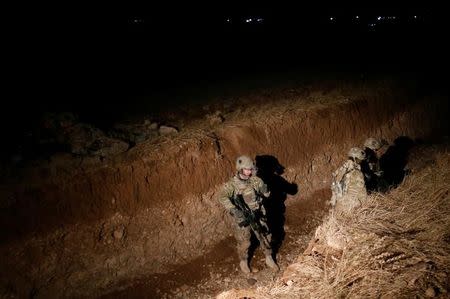Interview: U.S. forces embedding more to help Iraqis retake Mosul - commander
By Stephen Kalin MAKHMOUR, Iraq (Reuters) - U.S. forces assisting Iraqi troops to retake Mosul from Islamic State are embedding more extensively, a senior commander said on Friday, a move that could accelerate a two month-old campaign which has slackened after quick initial advances. More than 5,000 American service members are currently deployed in Iraq as part of an international coalition that is advising local forces in a bid to recapture the third of the country the jihadists seized in 2014 when Iraq's army and police dropped their weapons and fled. Coalition advisors were initially concentrated at a high-level headquarters in Baghdad but have fanned out over the past two years to multiple locations to stay near advancing troops. Now, as Iraqi forces controlling around a quarter of Mosul - Islamic State's last major stronghold in Iraq - proceed deeper into the northern city and encounter fierce counter-attacks that render progress slow and punishing, U.S. troops are stepping up their involvement. "We are deepening our integration with them," said U.S. Army Colonel Brett G. Sylvia. "We are now pushing that into more of the Iraqi formations pushing forward, some formations that we haven't partnered with in the past where we are now partnering with them." During a rare interview at the U.S. section of a base for Iraqi army and Kurdish peshmerga forces in Makhmour, 75 km (47 miles) southeast of Mosul, the combat brigade commander would not be drawn on whether his troops were operating inside Mosul proper. But Sylvia, who commands the 1,700-strong Task Force Strike, told Reuters the level of integration resembles that of small special operations teams embedding with larger indigenous forces to help build capacity. "We have always had opportunities to work side-by-side, but we have never been embedded to this degree," he said. "That was always a smaller niche mission. Well, this is our mission now and it is big and we are embedded inside their formations." Sylvia called the changes "a natural progression" of the U.S. mission, which is much narrower than the nine-year U.S. occupation that followed the invasion to topple Saddam Hussein when up to 170,000 troops were deployed. The coalition, which includes European and Arab allies, has also launched thousands of air strikes against Islamic State targets in Iraq and neighbour Syria, and trained tens of thousands of Iraqi forces since 2014. Separately, U.S. commandos have launched raids against senior Islamic State leaders. A top U.S. general told Reuters this week that Iraqi forces in Mosul had entered a planned operational refit, the first significant pause of the campaign which was launched on Oct. 17. But Sylvia said he believes the operation is approaching a "tipping point" in the eastern side of the city where Iraqi forces have advanced through around two dozen neighbourhoods since penetrating almost eight weeks ago. "When that momentum has the appearance of irreversibility then I think that we'll see a much more rapid seizure and clearance that occurs on the east side ... we're not (there yet)", he said. Mosul, an ancient city where up to 1.5 million people are thought to still be living, is divided roughly in half by the Tigris River. The western section has built-up markets and narrow alleyways dating back more than two millennia which will likely complicate advances. "They are different environments as you look at these areas," said Sylvia. "It's like saying Manhattan and Brooklyn are the same area. Clearly there's a different composition to them as you look at the two areas and that's the way this is as well." (Reporting By Stephen Kalin; Editing by Richard Balmforth)

 Yahoo News
Yahoo News 

